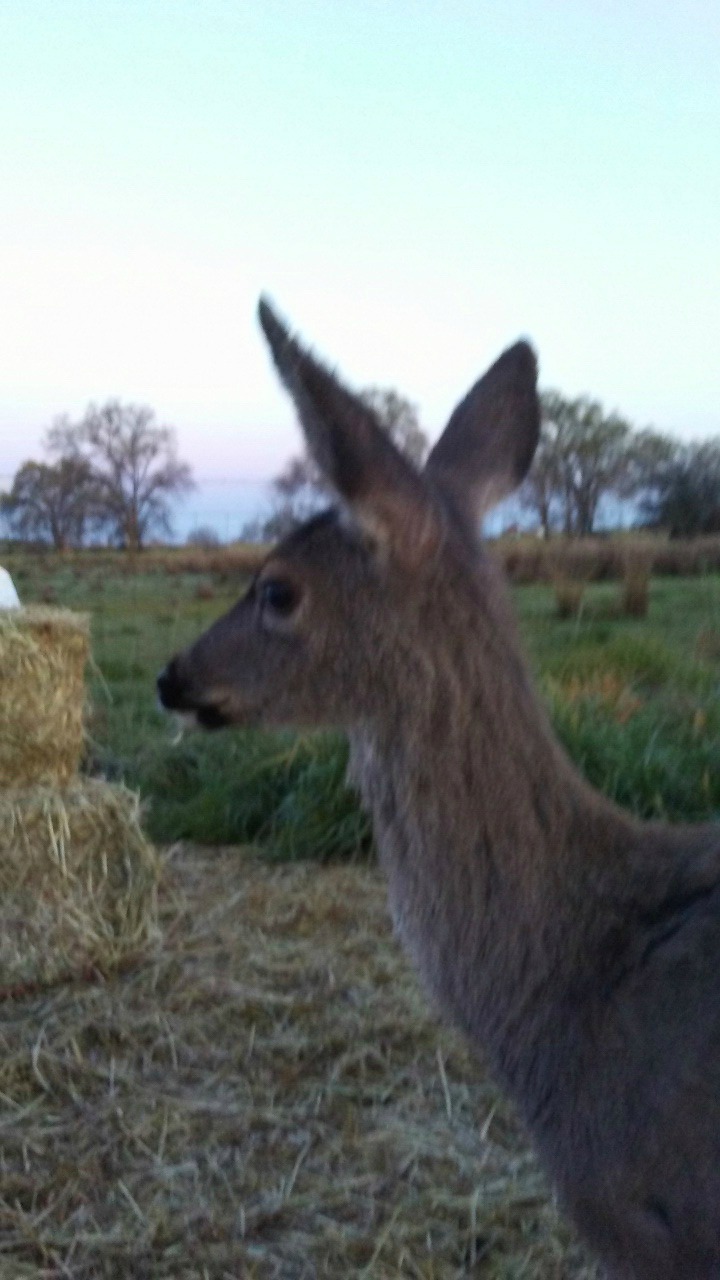Jane Doe
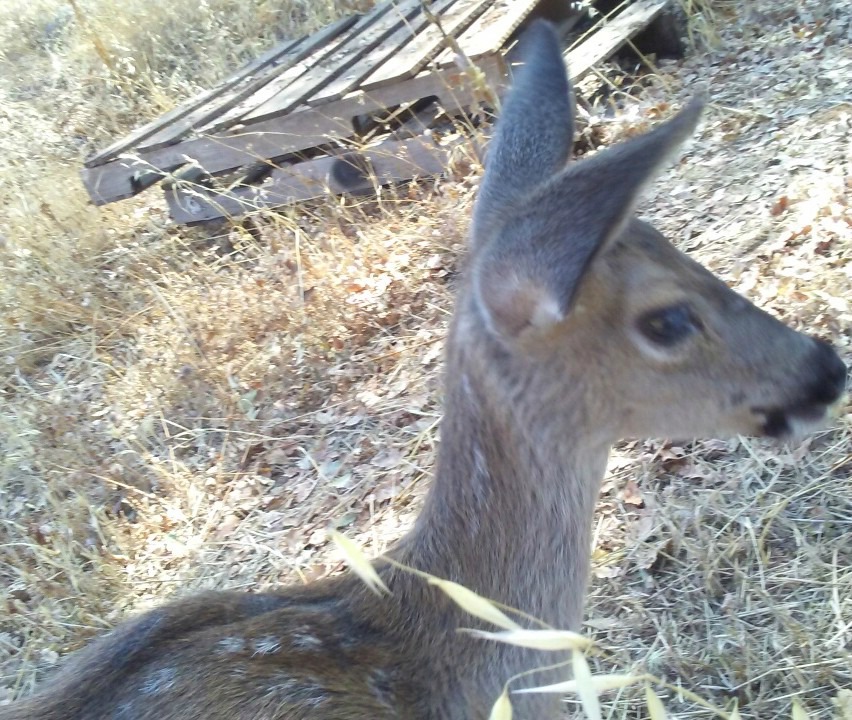
My Season with a Orphan Fawn
Every once and a while we find we are blessed unexpectedly, and the day little "Jane Doe" walked into my life is one of those 'tender mercies'.
One day last summer (2017) a small fawn, complete with spots, walked into the yard of the property I live on with my herd and she went right up to the landlord and his helper who were working on machinery in the driveway. She was very friendly and she stayed right by them while she browsed. They were able to pat her and she was not afraid, like any baby she wanted and expected to be loved on. I didn't meet her until several hours later when I came out to water the horses. She introduced herself to me as well. I noticed she was eating normal deer food, leaves on trees and shrubs and new growth plants, and she did not seem to be in any distress, but we were all wondering where her mom was.
Before you go all "Sierra Club" on me for handling a fawn realize i was adverse to humanizing her and thereby hurt her chances of survival, and to risk her own mother rejecting her because she carried human scent. And I voiced that concern to the two men, but they weren't hearing it, because they had other ideas having already decided they would make a pet of her. Within a few days others were notified by them of their "pet deer" and the stream of visitors started complete with their friends and children. Jane was happy to be loved by one and all, but was clearly overwhelmed at times by this petting zoo experience. I could see it was confusing to her and said so, but was overruled again.
I looked around for her mother, hoping she would reclaim her baby, but I never saw a adult deer, just little Jane. She would follow me when I fed the horses, and I was able fairly easily to convince her to bed down in the tall grass near the stallion paddocks. Coyotes are in the area and she would be easy prey, and it seemed the safest place for her at night with three stallion paddocks and a briar hedge along the neighboring pasture that contained three bulls. It would take a foolish coyote to cross those spaces to get to her. And she was happy with the arrangement as well, and would stay hidden until morning when she heard my voice she would then come out of the grassy hollow.
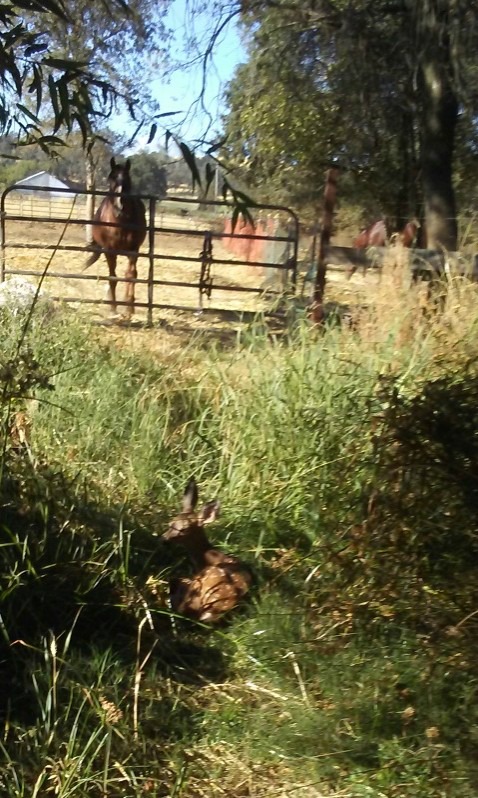
Her new "owners" decided they would learn what to do to care for her on the internet, and even though she was eating fine as it was they began bottle feeding her goat's milk because that what the internet article said. And Jane guzzled the milk right down. Also on the web's advice they got a bale of Alfalfa hay for her, even though she was content eating some of my horse's hay. She nibbled the Alfalfa and then ignored it, she liked other foods better. She was interested in the sweet cob grain mix I fed an aged mare for instance. They also thought that they would make a pen for her, but luckily I was able to convince them that it would make her helpless trapped prey for a coyote or mountain lion if she was contained.
A few weeks went by and Jane's health went downhill, she developed loose stools, open sores and oozing eyes. Watching this decline I became alarmed but I was in a tight position as I had to keep my landlord happy but somehow help this baby, and he and his helper were much invested in their status of deer rescuer. A friend stopped by who was also a livestock person and I asked her opinion on Jane's health. She too thought Jane was very ill. We then took pictures of her and emailed them to my veterinarian. He didn't feel confident evaluating her, but referred us to a deer rescue for advice. They looked at the pictures and the description of her symptoms and said right away she was too old to be on milk and it was causing gastric distress (somehow they could tell her age from the spot pattern on her coat) and to take her off it. I was very relieved when they offered to stop by and take a look at her for me. The next day they came by and even brought two sacks of deer feed (pellected) for her. Much to my relief they believed she would recover, and suggested to just take her off the milk and let her eat the pelleted grain. With an expert's opinion I took courage and informed the "owners" of the verdict, and explained that while they were trying to help her it was not the best diet for Jane. By that time they too had noticed her decline and they wanted the best for her. It was not long after that they lost interest in her day to day care and it all fell to me. I did not mind because I spend my day caring for my herd anyway, and of course she had utterly charmed me by then. We were all thrilled when Jane bounced back to health.
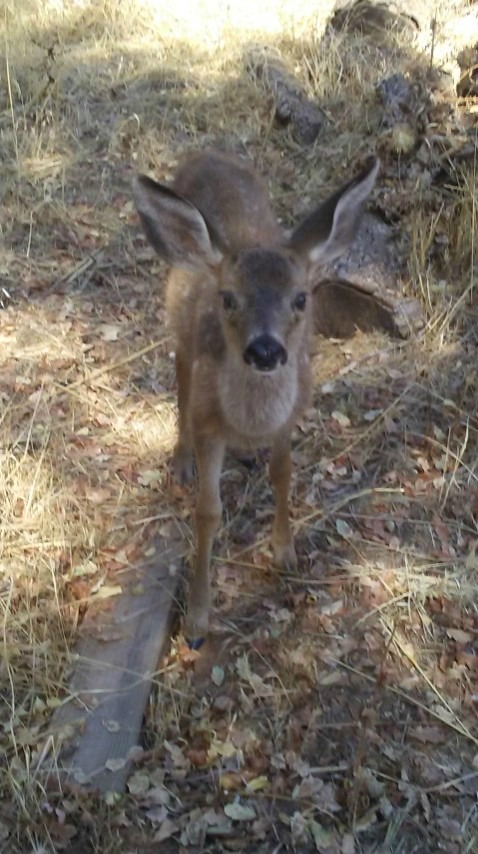
From then on it was Jane and me, her mother never came to claim her and with no other deer around we developed a bond. I would feed her twice a day the pelleted feed and she liked for me to sit by her while she ate it. Being the one usually outside and ranging the property caring for the animals, Jane would follow me when I did my rounds, sometimes coming right into the pasture and paddocks with me. The horses after the initial snorting and caution tolerated her, but they would chase her off if they were eating. They never tried to hurt her. The dogs on the property barked at her and when I walked some of the dogs in the morning she would trail behind us trying to be part of it. I could see her confusion, she had bonded with me, and she slept by the horses, but she did not fit in, and you could see her unease. She would try repeatedly to become friends with the horses, to see if they would take her into their herd, but they weren't interested, and the dogs had to be cautioned not to be aggressive. It was heart breaking, she had a real need to be part of a herd and there wasn't one, we never found her mother.
Then one day months later in what seemed like a miracle to me, Jane appeared for her breakfast with four other fawns! You could see her happiness and contentment and I was ecstatic watching her interact with real friends. She proudly showed me her new companions and it already appeared she had a special "best friend" among them, as they groomed each other and grazed together. I cried for joy watching them. The new babies were a little cautious at first and I did not approach them, nor would I look at them directly. They soon realized I was harmless and they eagerly joined in feeding with Jane and shortly the other fawns wanted my attention also...it was wonderful and just amazing to have five of these beautiful babies around me.
By this time you may be wondering as I did where these motherless fawns were coming from. Deer, even babies, don't just walk up to people, even the young ones hide in the brush from humans. This mystery began to unfold when my neighbor whose work took her to the forestry service was telling a ranger about the motherless herd that had arrived next door. He said he had heard that a whole bunch of orphan deer had been released by a rescue behind the property on a cattle ranch. Orphan deer! So, they were orphans, no moms, and had already been rescued. Evidently their mothers had been killed and each fawn was transferred to a rescue to save. They had been bottle fed until they were old enough to eat normal deer forage and then they were released. It all made sense then, Jane was an orphan who probably heard a human voice and came to it for food. And the other babies after several months found their way to Jane. So Jane and her little friends were already humanized, and they expected people to feed them. I felt better about the whole thing then.
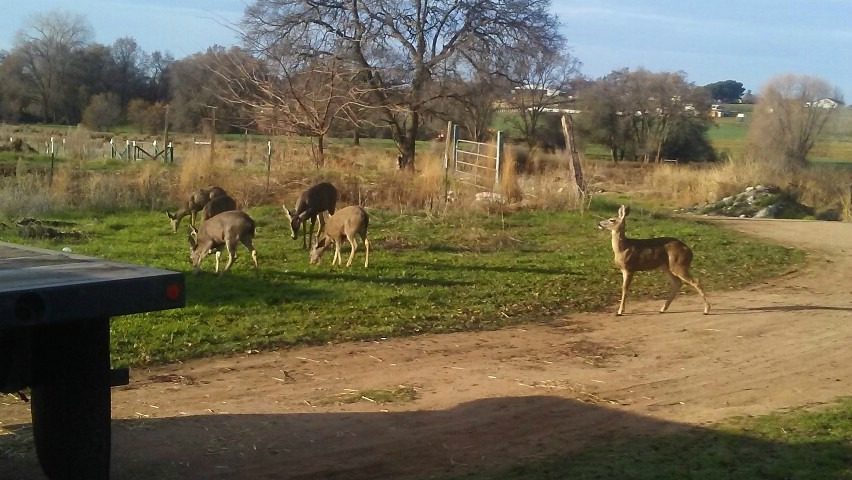
Life with the babies settled into a routine with five regular fawns coming for feed twice a day and bedding down near the horses. They are such extraordinary creatures, so very beautiful, gentle and graceful, and they are quiet, many times I turned to be surprised to see all of them right in back of me, never hearing them approach. They can be fast and as they got older they were able to jump the five foot pasture fences easily. I discovered that once they trust you they expect you to touch noses to greet you, and sometimes when they are really happy they jump and buck around you in play. The herd would swell occasionally, at one point there were seven of them traveling together as a group and they began to wander further away through the neighboring lands, but back every day to home base and the deer food.
While on one of their wanderings they learned a horrible lesson. I was outside mid-morning feeding the horses when the babies came tearing up the dry creek bed, they appeared terrified. They ran so fast they couldn't stop when they got to me and had to circle back to me. They were panting and frightened and I looked to see if a predator was following them. They calmed down after a while, and I examined them for wounds but found none, but it was then I noticed one of them was missing. I walked up the creek bed to see if I could find the fawn, but no sign of her. I kept looking for her, but she never showed up and the others stayed close by for days. I kept searching the sky for buzzards, which usually come if there is a carcass, but never saw one, so I was hoping that she was just hurt and that I would find her and get her help. Then two days later I smelled flesh decaying at the end of the property by the road, but still could not locate her. It was the landlord that finally found her when he was retrieving his mail at the road, he thought she was in the deep ditch beyond his mail box. I went there and yes, he was right, it was one of the babies, obviously hit by a car and landed in the deep ditch. The others must have been with her when it happened which explains their terror and race to get home.
Things got back to normal and the remaining six expanded their range; I estimate now they roam around one-hundred acres through the farm and other neighbor's land and then back again. Some days I don't see them and only know they have been around by the empty food bowl.
Rutting season occurs in the fall-winter and the girls in the herd were coming into heat (7 months old), and a two year old buck showed up one day and stayed with the herd for a few months traveling with them. He had small antlers, a few inches long, and he was not a rescue, he was wild. He disappeared suddenly one day, and then the reason stepped out of the trees: a full grown adult buck, tall with a big rack of antlers; he was breathtaking in his majesty. The big boy only hung around a few days, and he vanished as mysteriously as he appeared. The two year old came back then and stayed a few more weeks, then he too left the group. Also after this rutting season the herd had somehow been shuffled, Jane and two of her original friends were still there, but two small new ones were now part of this group and Jane's best friend was no longer with them.
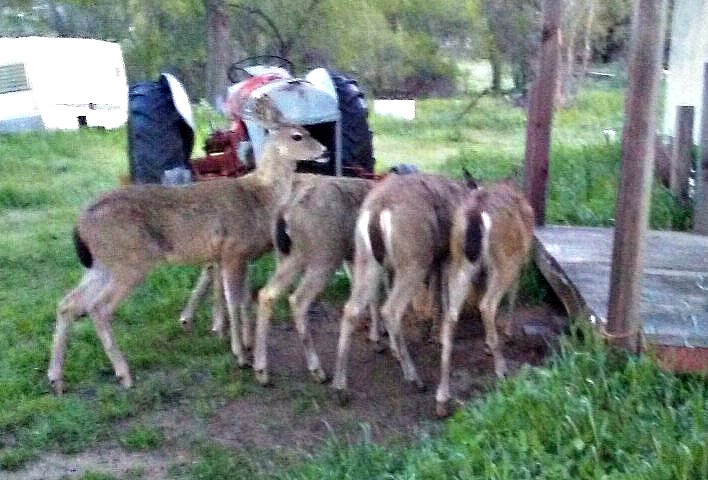
They are growing up and Jane will still come to me and even run to me, but the others have less need to be handled...as it should be, and some days I don't see them at all. I think I was feeling a little of the 'empty nest' syndrome and bittersweet about them, happy they had adapted to life in the wild but sad they needed me no longer. Then yesterday morning at dawn when I was topping off their bowl with grain, the whole group came racing into the clearing to get to me. I could hear a pack of coyotes on the farm behind us close by from the direction they came from. They gathered around me again like they were babies, and I checked them for wounds and tried to calm them. None of them were hurt, and the coyotes were probably after the calves next door rather then them, but it was close enough to spook them. And they stayed by me, following me down the driveway to the hay storage and back again with the wagon to feed the horses like they were babies again. For a few days they stayed close by and then resumed their wanderings. I am happy to see they know they can come back 'home' to safety, but I don't fool myself, the season has changed. They are babies no longer, and they are quietly becoming a wild herd again. What a marvelous blessing to have known these graceful and beautiful wild creatures as friends.
